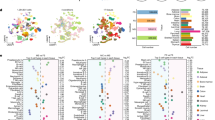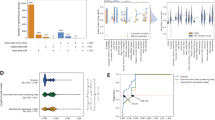Abstract
We carried out a genome-wide association study in 296 individuals with male-pattern baldness (androgenetic alopecia) and 347 controls. We then investigated the 30 best SNPs in an independent replication sample and found highly significant association for five SNPs on chromosome 20p11 (rs2180439 combined P = 2.7 × 10−15). No interaction was detected with the X-chromosomal androgen receptor locus, suggesting that the 20p11 locus has a role in a yet-to-be-identified androgen-independent pathway.
This is a preview of subscription content, access via your institution
Access options
Subscribe to this journal
Receive 12 print issues and online access
$209.00 per year
only $17.42 per issue
Buy this article
- Purchase on Springer Link
- Instant access to full article PDF
Prices may be subject to local taxes which are calculated during checkout

Similar content being viewed by others
References
Nyholt, D.R., Gillespie, N.A., Heath, A.C. & Martin, N.G. J. Invest. Dermatol. 121, 1561–1564 (2003).
Ellis, J.A., Stebbing, M. & Harrap, S.B. J. Invest. Dermatol. 116, 452–455 (2001).
Hillmer, A.M. et al. Am. J. Hum. Genet. 77, 140–148 (2005).
Ellis, J.A. et al. Hum. Genet. 121, 451–457 (2007).
Lotufo, P.A., Chae, C.U., Ajani, U.A., Hennekens, C.H. & Manson, J.E. Arch. Intern. Med. 160, 165–171 (2000).
Matilainen, V., Koskela, P. & Keinänen-Kiukaanniemi, S. Lancet 356, 1165–1166 (2000).
Hamilton, J.B. Ann. NY Acad. Sci. 53, 708–728 (1951).
Norwood, O.T. South. Med. J. 68, 1359–1365 (1975).
The Wellcome Trust Case Control Consortium. Nature 447, 661–678 (2007).
Cordell, H.J. & Clayton, D.G. Am. J. Hum. Genet. 70, 124–141 (2002).
Kleinjan, D.A. et al. Dev. Biol. 299, 563–581 (2006).
Paik, J.H., Yoon, J.B., Sim, W.Y., Kim, B.S. & Kim, N.I. Br. J. Dermatol. 145, 95–99 (2001).
Hillmer, A.M. et al. Am. J. Hum. Genet. 82, 737–743 (2008).
Risch, N. & Merikangas, K. Science 273, 1516–1517 (1996).
Barrett, J.C., Fry, B., Maller, J. & Daly, M.J. Bioinformatics 21, 263–265 (2005).
Acknowledgements
We thank all probands for participating in the study and providing blood samples. This study was supported by the Deutsche Forschungsgemeinschaft (FOR 423 and Emmy Noether) and the Alfried Krupp von Bohlen und Halbach-Stiftung. The Heinz Nixdorf Recall cohort was established with the support of the Heinz Nixdorf Foundation (G. Schmidt, Chairman).
Author information
Authors and Affiliations
Contributions
M.M.N. and R.K. initiated the study; A.M.H. and F.F.B. contributed to the study design; M.M.N. and A.M.H. coordinated the work and prepared the manuscript, with feedback from the other authors; R.K., S. Hanneken, S.E., and A.-K.K. diagnosed the affected and unaffected German individuals and collected the blood samples; S.M., K.-H.J., M.B.-P. and R.E. recruited and characterized German population controls; N.G.M. and D.R.N. recruited and characterized Australian sample; F.F.B., T.W.M., M.A.A., Z.Z.Z., G.W.M. and R.R. prepared DNA and performed genotyping; M.S., A.F., S. Herms, T.B., and D.R.N. performed statistical analysis; F.F.B. performed expression analysis. M.M.N., A.M.H., F.F.B., T.B., N.G.M, D.R.N., T.F.W., M.P.B., S.C., P.P., and R.C.B. analyzed and interpreted data.
Corresponding author
Ethics declarations
Competing interests
M.M.N., R.K., A.M.H. and F.F.B. declare competing financial interests because of their patent application (European patent 08 00 6933.9).
Supplementary information
Supplementary Text and Figures
Supplementary Tables 1–4, Supplementary Figures 1–4 and Supplementary Methods (PDF 412 kb)
Rights and permissions
About this article
Cite this article
Hillmer, A., Brockschmidt, F., Hanneken, S. et al. Susceptibility variants for male-pattern baldness on chromosome 20p11. Nat Genet 40, 1279–1281 (2008). https://doi.org/10.1038/ng.228
Received:
Accepted:
Published:
Issue Date:
DOI: https://doi.org/10.1038/ng.228
This article is cited by
-
Analysis of 72,469 UK Biobank exomes links rare variants to male-pattern hair loss
Nature Communications (2023)
-
Reliability of phenotype estimation and extended classification of ancestry using decedent samples
International Journal of Legal Medicine (2021)
-
Misestimation of heritability and prediction accuracy of male-pattern baldness
Nature Communications (2018)
-
GWAS for male-pattern baldness identifies 71 susceptibility loci explaining 38% of the risk
Nature Communications (2017)
-
Forensically relevant SNaPshot® assays for human DNA SNP analysis: a review
International Journal of Legal Medicine (2017)



